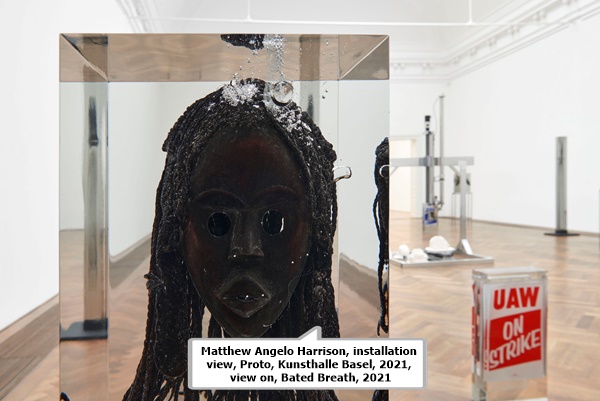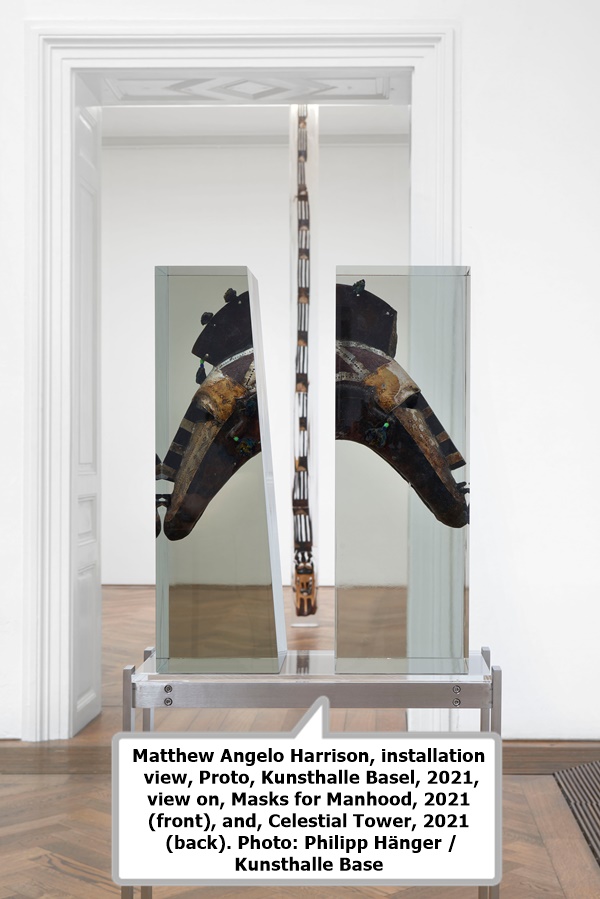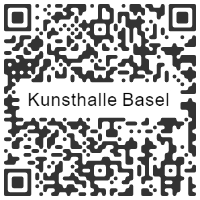"PROTO"

Tel +1 (415) 255-9508 e-mail:This email address is being protected from spambots. You need JavaScript enabled to view it.





T +41 61 206 99 00 F +41 61 206 99 19 emailThis email address is being protected from spambots. You need JavaScript enabled to view it.




Matthew Angelo Harrison
presented by the gallery :
Jessica Silverman Gallery
621 Grant Avenue San Francisco, CA, US 94108Tel +1 (415) 255-9508 e-mail:




Kunsthalle Basel
Steinenberg 7 CH-4051 BaselT +41 61 206 99 00 F +41 61 206 99 19 email
June 6 > September 26, 2020




Like dragonflies in amber, Ma#hew Angelo
Harrison’s polished blocks of transparent resin
are time capsules of a sort. !ey populate the
artist’s first solo exhibition in Europe—featuring
all new work and his most ambitious project
to date—where the personal and ancestral
collide with the historical and political. Lumi- nous prisms of varying opacity (some tinted,
some clear) encase wooden African e"gies,
ceremonial masks, long-handled spears, or, in
a single spectacular case, a nearly five-meterhigh totem with a head at its base. Hailing from
the cultures of Bambara, Dogon, Makonde,
Senufo, and others, most are a#ributed to unknown makers and were bought by the
artist from European secondary market dealers
selling on the internet. !e digital trade
routes that these objects traveled—contemporary versions of those that once carried
enslaved Africans across the Atlantic Ocean—
interest Harrison, just like the transnational
transactions, dispossession, and violence
that the circulation of these objects chronicles.
!e interruption of this tra"c by the artist is central to understanding his practice, as is the recirculation of the artifacts in an a#empt to complicate how we think about the colonial project and track its enduring legacy in the twenty-first century.
!e exhibition opens with a clear resin block containing a mid-twentieth-century mask from the Dan tribe, its gouged eyeholes and tendrils of hair floating amongst air bubbles, appearing to be submerged in water but miraculously breathing. For now. Entitled Bated Breath, the sculpture summons another time and place, traditions and rituals far from the US where the artist made it or Europe, where it now stands. Yet, it also eerily portends a moment when the words “I can’t breathe” have become a rallying call. Equally, Reservoir Master—presented at some distance behind Bated Breath and containing a Dogon Nommo figure with its hands up—recalls the gesture signaling submission to the police, now also doubling as an iconic protest gesture in the struggle against continued police killings of unarmed people of color. Like any time capsule, Harrison’s objects speak not only of the past but also to the present..
Sca#ered among these are blocks that envelop workers’ protective gear or labor union para- phernalia—some dating from the last major US United Auto Workers (UAW) strikes of the 1990s. !ese may not be the spoils of conquest and colonial rule, but they are Black relics of another sort—born from African-American labor and collected by the artist’s own mother and her union colleagues. !ey underline the critical intersection of colonialism, low-wage labor, and technology at the core of Harrison’s concerns..
Among his prismatic forms are those cut into stacked segments or etched using a CNC router (computer-controlled milling machine) to create surfaces and cavities with no less complexity than a car’s engine block. So it is with Bodily Study: Inverted W, in which the gloves of a worker seem so mangled by the cuts of the CNC router that they are hardly recognizable. Or, Single Mother (Divided), in which the artist’s own mother’s unionembossed bomber jacket encounters similar treatment..
African artifacts face such cuts and deformations, too. Observe the resin-embedded wooden mask in !e Navigator or figurine of a boy in Touched By an Angel, each rendered partly illegible by the mechanical hive of cylindrical holes and raised nodes surrounding
!e interruption of this tra"c by the artist is central to understanding his practice, as is the recirculation of the artifacts in an a#empt to complicate how we think about the colonial project and track its enduring legacy in the twenty-first century.
!e exhibition opens with a clear resin block containing a mid-twentieth-century mask from the Dan tribe, its gouged eyeholes and tendrils of hair floating amongst air bubbles, appearing to be submerged in water but miraculously breathing. For now. Entitled Bated Breath, the sculpture summons another time and place, traditions and rituals far from the US where the artist made it or Europe, where it now stands. Yet, it also eerily portends a moment when the words “I can’t breathe” have become a rallying call. Equally, Reservoir Master—presented at some distance behind Bated Breath and containing a Dogon Nommo figure with its hands up—recalls the gesture signaling submission to the police, now also doubling as an iconic protest gesture in the struggle against continued police killings of unarmed people of color. Like any time capsule, Harrison’s objects speak not only of the past but also to the present..
Sca#ered among these are blocks that envelop workers’ protective gear or labor union para- phernalia—some dating from the last major US United Auto Workers (UAW) strikes of the 1990s. !ese may not be the spoils of conquest and colonial rule, but they are Black relics of another sort—born from African-American labor and collected by the artist’s own mother and her union colleagues. !ey underline the critical intersection of colonialism, low-wage labor, and technology at the core of Harrison’s concerns..
Among his prismatic forms are those cut into stacked segments or etched using a CNC router (computer-controlled milling machine) to create surfaces and cavities with no less complexity than a car’s engine block. So it is with Bodily Study: Inverted W, in which the gloves of a worker seem so mangled by the cuts of the CNC router that they are hardly recognizable. Or, Single Mother (Divided), in which the artist’s own mother’s unionembossed bomber jacket encounters similar treatment..
African artifacts face such cuts and deformations, too. Observe the resin-embedded wooden mask in !e Navigator or figurine of a boy in Touched By an Angel, each rendered partly illegible by the mechanical hive of cylindrical holes and raised nodes surrounding
 | Matthew Angelo Harrison | |
Opening weekend with free admission :
June 3 – 6, 2021
June 3 – 6, 2021
mpefm
SWTITZERLAND art press release
Opening Times:
Mon closed Tue/Wed/Fri 11 am–6 pm Thu 11 am–8:30 pm Sat/Sun 11 am–5 pm
ADMISSION
CHF 12.—/8.—
incl. S AM Swiss Architecture Museum
Free Entrance
Children up to 18 years of age, People with disabilities and their escorts, Immigrants (with identification card N, F), Members of Basler Kunstverein, Friends of Kunsthalle Basel, Media, ICOM / VMS, Museums-Pass-Musée (before: Oberrheinischer Museumspass), Schools BS+BL, Teachers of Fine Arts BS and BL, Kunsthistorisches Seminar BS, Schule für Gestaltung Basel (SfG), FHNW Academy of Art and Design, Colour Key, COMEX Comission Exécutive Musées, Freiwilliger Museumsverein Basel (FMB), Museum staff Basel

ADMISSION
CHF 12.—/8.—
incl. S AM Swiss Architecture Museum
Free Entrance
Children up to 18 years of age, People with disabilities and their escorts, Immigrants (with identification card N, F), Members of Basler Kunstverein, Friends of Kunsthalle Basel, Media, ICOM / VMS, Museums-Pass-Musée (before: Oberrheinischer Museumspass), Schools BS+BL, Teachers of Fine Arts BS and BL, Kunsthistorisches Seminar BS, Schule für Gestaltung Basel (SfG), FHNW Academy of Art and Design, Colour Key, COMEX Comission Exécutive Musées, Freiwilliger Museumsverein Basel (FMB), Museum staff Basel
QR of this press release
in your phone, tablet








